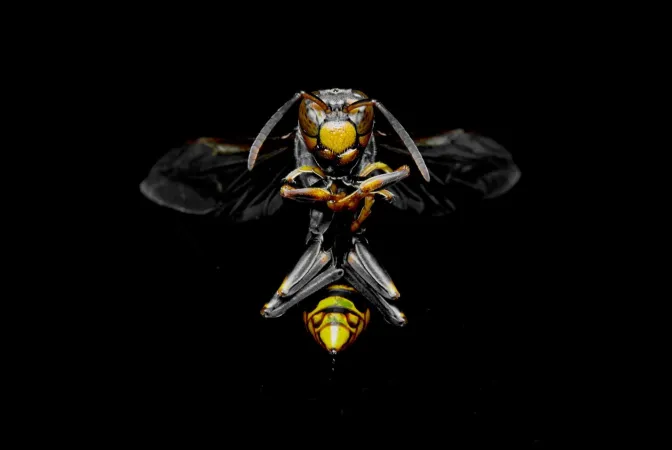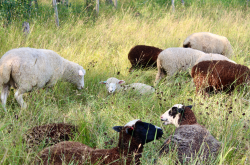A conversation with a honeybee (Part 2)
Yesterday, in part 1 of “A conversation with a honeybee,” we began imagining what a honeybee might say if it had the chance to chat with a human.* The story continues below.
I went inside to get an essential oil diffuser, to gently repel the mosquitos. As I was about to return to my tree to rest and start reading again, I heard some buzzing next to my flower bush. There was the bee, and she was counting, “Nine-hundred ninety nine flowers, one thousand flowers, one thousand and one flowers…”
“I thought you’d left!” I said excitedly. “I’m glad you’re still here; I really think you need to rest a bit more.”
I noticed she was still panting. “From what you’ve told me, your job is very demanding and you seem pretty stressed out. I have been through times when work was a bit overwhelming. You’ve got to learn to relax and take a break!”
I thought for a moment, then said, “When I see bees buzzing around, I assume that you’re having fun – enjoying nature. I hope it helps to work outside and enjoy the beautiful weather?”
For a second, she looked puzzled — as if she did not understand what I had said. Then she replied, “Oh yes! But I miss the wildness of my youth, with its pure water and air. These areas are now often contaminated with irritants and pollutants [1, 2, 3]”. She turned and showed some redness on the back of her head, and areas where hair had fallen off of her torso.”
“Oh that’s terrible!” I said. “But there seems to be an increased focus on pollution prevention, waste management, and other sustainable practices — in addition to the use of organic products in food production! Perhaps you’re just be a bit sensitive or allergic to some substances.”
I added that some chemicals could be challenging for pollinators and birds, but there is ongoing research to formulate and identify non-toxic chemical combinations that are tolerated by bees.
She looked at me with her big eyes. “I am not allergic,” she replied. “I am equipped with cutting-edge sensing technology — with hundreds of receptors to differentiate scents. I can even taste with my feet! [4, 5]
There is definitely more pollution, and other species are not doing well either. Even low concentrations of toxic molecules, released far away, can accumulate in higher concentrations in some plants [6]”.
She continued in a sombre tone, “I come back from work some days to find many of my forager colleagues never made it back!” She was silent for a moment. “It’s getting worse. Our life span is decreasing and many colonies in the area just…”
”Just what?” I asked.
“Disappear,” she said finally. “There are even bizarre incidents where worker bees start acting differently and forget what to do. Our queen thinks it may be toxic substances sprayed by our neighbours that disturb our memory and brain function. [7]”
She sighed. “A wise, old queen bee told me about a time when the earth was noisier and busier. She explained that bees were healthier because their immune system was stronger. By living in a more diverse ecosystem, they fell sick less often and recovered from bacterial and fungal infections faster [8, 9]”.
She continued, “I do hope scientists can come up with better solutions to reduce pollutants and deal with diseases and pests; I understand it’s challenging. Maybe they can figure out a way to get nature to do the work for them. There are many examples in nature of bugs that eat pests, or good bacteria that disables pathogenic microorganisms without the need for chemicals. [10, 11]”
I smiled and joked, “Are you talking about the power of Mother Nature? I’m sure it will get better. There are many scientists working on technologies that will help honey bees. Experienced beekeepers and businesses are also developing techniques — based on scientific research — to help your colonies fight infestation, mites, and reduce stress.”
But the bee still looked anxious. “I have to go back to work now; I have a lot to do.”
I responded, “Feel free to come back whenever you like to eat some honey. It will make you feel better.”
Once again, I blinked my eyes and found myself resting under the tree — wondering if it was all just a crazy dream. I stayed there for a few minutes, quietly contemplating the life of honeybees…as a soft buzzing floated around my apple tree.
7 easy ways to help the honeybees
Consume LOCAL honey: Beekeepers in your area are able to maintain healthy colonies of pollinators that we need in our environment and for our crops.
Give sugar (or honey) to bees: You can leave a mix of two tablespoons of sugar or honey with one tablespoon of water for exhausted bees, who require carbohydrates from sugars in nectar or honey to convert into much-needed energy.
Plant flowers bees like: Plant pollinator-friendly plants, such as primrose, butterfly bush, and marigolds.
Make space for bees in your garden: Leave an area of the garden untended, to allow bees to buzz around in the long grass or make nests.
Follow pollinator-friendly best practices: Certain pesticides and chemicals can pose a risk to pollinators, particularly when plants are in bloom.
Host a beehive: Even if you know little about caring for honeybees you can still register to host a beehive and put it in your garden! Some businesses will take care of it for you, so you can enjoy the honey from your hive.
Become a beekeeper: Why not?
Want to learn more about honeybees? On August 18, you can get the buzz on these important insects at the Canada Agriculture and Food Museum in celebration of World Honeybee Day!
Coming soon: Can the iPhone help the honeybees?
Algonquin College Culinary instructors have teamed up with TwelveDots Labs to enable students to monitor honeybee colonies from a distance. In a secondary apiary at the Canada Agriculture and Food Museum, a HiveSense — which is a sensor device inserted into the hive — can record information about honeybees without disturbing them.
Find more details in our next article — or visit the Canada Agriculture and Food Museum to see for yourself!
*Disclaimer: The views and opinions expressed in this article are those of the author, they don’t reflect the official position of The Canada Agriculture and Food Museum, or bees in general. However, all scientific information used in this text is referenced from the resources listed below.
[1] Mathieu Giraudeau, et al., "Human activities might influence oncogenic processes in wild animal populations," Nature Ecology & Evolution, volume 2, pages1065–1070 (2018).
[2] Zhang et al., "Transboundary health impacts of transported global air pollution and international trade," Nature, volume 543, pages 705–709 (30 March 2017).
[3] Jerome O. Nriagu & Jozef M. Pacyna, "Quantitative assessment of worldwide contamination of air, water and soils by trace metals," Nature, volume 333, pages 134–139 (12 May 1988).
[4] ML Winston, The biology of the honey bee (1991).
[5] TD Seeley, The wisdom of the hive: the social physiology of honey bee colonies (2009).
[6] McArt et al., "High pesticide risk to honey bees despite low focal crop pollen collection during pollination of a mass blooming crop," Scientific Reports, volume 7, Article number: 46554 (2017)
[7] Stanley et al., "Bumblebee learning and memory is impaired by chronic exposure to a neonicotinoid pesticide," Scientific Reports, volume 5, Article number: 16508 (2015).
[8] Samuelson et al., "Effect of acute pesticide exposure on bee spatial working memory using an analogue of the radial-arm maze," Scientific Reports, volume 6, Article number: 38957 (2016).
[9] Keesing et al., "Impacts of biodiversity on the emergence and transmission of infectious diseases," Nature, volume 468, pages 647–652 (02 December 2010).
[10] Hua et al., "Opportunities for biodiversity gains under the world’s largest reforestation programme," Nature Communications, volume 7, Article number: 12717 (2016).
[11] Christelle et al., "Root exudate metabolites drive plant-soil feedbacks on growth and defense by shaping the rhizosphere microbiota," Nature Communications, volume 9, Article number: 2738 (2018).
















